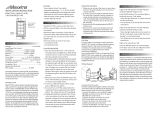
PM11 Electronic pressure sensor
2
Contents
1 Preliminary note ............................................................. 3
1.1 Symbols used.......................................................... 3
2 Safety instructions............................................................ 4
3 Intended use................................................................ 5
3.1 Application area ........................................................ 5
4 Function ................................................................... 6
4.1 IO-Link ............................................................... 6
4.2 IO-Link properties of the sensor ............................................ 6
4.2.1 Description IO-Link interface........................................... 6
4.2.2 Additional functions via IO-Link......................................... 6
4.3 Defined state in case of a fault ............................................. 7
4.4 Operating modes ....................................................... 7
4.4.1 2-wire operation .................................................... 7
4.4.2 3-wire operation .................................................... 7
4.5 Analogue output........................................................ 7
5 Installation.................................................................. 9
5.1 Use in hygienic areas according to 3-A . . . . . . . . . . . . . . . . . . . . . . . . . . . . . . . . . . . . . . . 10
5.2 Use in hygienic areas to EHEDG ........................................... 10
5.3 Ventilation diaphragm.................................................... 10
5.3.1 Function ventilation diaphragm......................................... 10
5.3.2 Orientation filter cover................................................ 11
5.3.3 Replace filter cover.................................................. 11
6 Electrical connection.......................................................... 13
7 Parameter setting............................................................ 14
7.1 Parameter setting via PC ................................................. 14
7.2 Parameter setting via the memory plug . . . . . . . . . . . . . . . . . . . . . . . . . . . . . . . . . . . . . . . 14
7.3 Teach offset with button .................................................. 15
7.4 Scale analogue value.................................................... 15
7.5 Setting of the standard unit of measurement. . . . . . . . . . . . . . . . . . . . . . . . . . . . . . . . . . . 15
7.6 User settings (optional)................................................... 15
7.6.1 Zero-point calibration ................................................ 15
7.6.2 Set damping for the analogue output . . . . . . . . . . . . . . . . . . . . . . . . . . . . . . . . . . . . 15
7.7 List of the parameters.................................................... 16
7.8 Diagnostic functions ..................................................... 16
7.8.1 Read min/max values for the system pressure . . . . . . . . . . . . . . . . . . . . . . . . . . . . . 16
8 Operation .................................................................. 17
9 Troubleshooting ............................................................. 18
10 Disposal, repair and return..................................................... 19
11 Factory setting .............................................................. 20


























